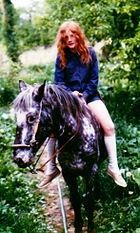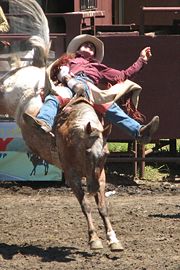
Bareback riding
Encyclopedia

Equestrianism
Equestrianism more often known as riding, horseback riding or horse riding refers to the skill of riding, driving, or vaulting with horses...
without a saddle
Saddle
A saddle is a supportive structure for a rider or other load, fastened to an animal's back by a girth. The most common type is the equestrian saddle designed for a horse, but specialized saddles have been created for camels and other creatures...
. It requires skill, balance, and coordination, as the rider does not have any equipment to compensate for errors of balance or skill.
Proponents of bareback riding argue that riding in this fashion is natural, allows considerable communication with the horse, and improves a rider's balance. The drawbacks include a higher risk of injury due to an increased risk of falling off the horse, the potential to develop poor riding form, and the possibility of considerable discomfort to both horse and rider due to the absence of a supporting tree and any padding between the rider's seat bones and the horse's spine. Over time, it is more fatiguing to both horse and rider to ride bareback.
However, in certain situations, bareback riding is particularly suitable. Many riders will ride bareback for a short ride in order to save time in a busy day. It is also common for a rider who will take a horse in only one direction and walk back on foot, such as when moving the horse from one pasture to another, to ride the horse in only a bridle in order to not carry much equipment when returning. In other cases, for example, if a horse is to be allowed to swim in a river, lake or ocean, it is practical to leave expensive leather horse tack
Horse tack
Tack is a term used to describe any of the various equipment and accessories worn by horses in the course of their use as domesticated animals. Saddles, stirrups, bridles, halters, reins, bits, harnesses, martingales, and breastplates are all forms of horse tack...
off to avoid equipment damage. It is also common for riders in extreme cold weather to ride bareback for short pleasure rides in situations where heavy winter clothing makes it hazardous to ride with a saddle due to the difficulty of sitting correctly in a saddle while wearing thick insulated clothing or the potential of a large snow boot
Snow boot
A snow boot is a type of boot, generally waterproof, or water-resistant. The boot, in almost all cases, has a high side, keeping snow from entering the boot, and a rubber sole, to keep water out. Because of their water-resistant material, snowboots are often used in wet, slushy, or muddy situations...
hanging in a stirrup.
Rider position
When riding bareback, riders sit a bit more forward on the horse than they would in a saddle. They have to rest their legs more forward, along the crease between the barrel and the shoulder muscles in order to have a secure position without excessive gripping. As a rule, to make proper use of the rider's calf muscles, bareback riders need to keep their heels lower than their toes, riding with a flexed ankle and heel down, just as if they had stirrupStirrup
A stirrup is a light frame or ring that holds the foot of a rider, attached to the saddle by a strap, often called a stirrup leather. Stirrups are usually paired and are used to aid in mounting and as a support while using a riding animal...
s. Riding with the toes down can lead to clutching at the horse with the lower legs or digging into the horse's sides with the heels, both often interpreted by the horse as a leg cue
Riding aids
Riding aids are the cues a rider gives to a horse to communicate what they want the animal to do. Riding aids are broken into the natural aids and the artificial aids.-Natural aids:...
to go faster. Hands need to hold the rein
Rein
Reins are items of horse tack, used to direct a horse or other animal used for riding or driving. Reins can be made of leather, nylon, metal, or other materials, and attach to a bridle via either its bit or its noseband.-Use for riding:...
s quietly, in a position similar to how they would be carried if a rider was using a saddle.
It is particularly important that riders do not squeeze their heels or lower legs into the horse
Horse
The horse is one of two extant subspecies of Equus ferus, or the wild horse. It is a single-hooved mammal belonging to the taxonomic family Equidae. The horse has evolved over the past 45 to 55 million years from a small multi-toed creature into the large, single-toed animal of today...
's sides when slowing or stopping, or use the rein
Rein
Reins are items of horse tack, used to direct a horse or other animal used for riding or driving. Reins can be made of leather, nylon, metal, or other materials, and attach to a bridle via either its bit or its noseband.-Use for riding:...
s as a brace at any time, as these errors will send the horse confusing, contradictory signals. If riders lose their balance, it is common to grab the mane
Mane (horse)
The mane is the hair that grows from the top of the neck of a horse or other equine, reaching from the poll to the withers, and includes the forelock or foretop. It is thicker and coarser than the rest of the horse's coat, and naturally grows to roughly cover the neck...
in order to prevent jerking the horse in the mouth with the reins of the bridle
Bridle
A bridle is a piece of equipment used to direct a horse. As defined in the Oxford English Dictionary, the "bridle" includes both the headstall that holds a bit that goes in the mouth of a horse, and the reins that are attached to the bit....
, though ideally a rider can maintain proper balance by correct placement and use of their thigh and upper calf muscles.
Though some people begin riding bareback before they learn with a saddle
Saddle
A saddle is a supportive structure for a rider or other load, fastened to an animal's back by a girth. The most common type is the equestrian saddle designed for a horse, but specialized saddles have been created for camels and other creatures...
, it is usually recommended to first learn in a saddle without stirrup
Stirrup
A stirrup is a light frame or ring that holds the foot of a rider, attached to the saddle by a strap, often called a stirrup leather. Stirrups are usually paired and are used to aid in mounting and as a support while using a riding animal...
s, as the rider is still helped in obtaining correct position by the pommel and cantle, but is not able to use the stirrups as a crutch for poor balance or position. It is also easier on the horse's back to have the support of a saddle to cushion the action of an unbalanced rider.
Rodeo

Rodeo
Rodeo is a competitive sport which arose out of the working practices of cattle herding in Spain, Mexico, and later the United States, Canada, South America and Australia. It was based on the skills required of the working vaqueros and later, cowboys, in what today is the western United States,...
. Bareback bronc
Bronco
Bronco, or bronc is a term used in the United States, northern Mexico and Canada to refer to an untrained horse or one that habitually bucks. It may refer to a feral horse that has lived in the wild its entire life, but is also used to refer to domestic horses not yet fully trained to saddle, and...
riding is one of the most physically demanding events in rodeo, with a high injury rate. Cowboy
Cowboy
A cowboy is an animal herder who tends cattle on ranches in North America, traditionally on horseback, and often performs a multitude of other ranch-related tasks. The historic American cowboy of the late 19th century arose from the vaquero traditions of northern Mexico and became a figure of...
s ride the bucking horse one-handed and cannot touch or hang onto anything with their free hand. They use a leather rigging that includes a handle that resembles that of a suitcase, where riders place their hand. To make the event more difficult for the rider, they are required to lean back and spur in a highly stylised manner that was never historically used in actual practice. The cowboy's spurs have to be above the point of the horse's shoulders at the first jump out of the chute and touch the horse on every jump for the full time required for a qualifying ride. They have to stay on the horse and ride with proper technique for 8 seconds in order for the ride to be judged and scored. Once the ride is complete the rider may hold on to the rigging with both hands until reached by the pickup rider
Pickup rider
A pickup rider is a person on horseback who works at a rodeo in the rough stock competitions of bull riding, Saddle bronc and bareback riding. Pickup riders play an important role in assisting rodeo riders and increasing the safety of competitors....
s, who assist the rider in getting off the still-moving horse and safely on the ground. Cowboys are judged on their control and spurring technique, and the horse is judged on their power, speed, and agility. These two scores are added together to make the total, with the highest possible score being 100 points.

